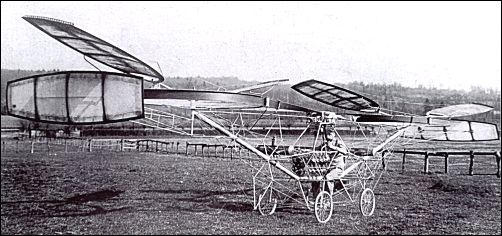
| Cornu helicopter project |  |
 |

| Cornu helicopter project |  |
 |
|
The first true flight, free of any tie-down ropes, apparently was made by Paul Cornu, in another French machine later the same year, on November 13. His helicopter had two rotors mounted in tandem, one behind the other. The pilot sat between them, in intimate proximity to the little 24-horsepower Antoinette engine. The helicopter rose no more than 2m, and the longest flight lasted only a third of a minute. Nevertheless, it flew, completely free of any attachment to the ground. Today it would be said that the pilot "had not gotten out of ground effect". To steer, to rock the ship from side to side, or to nose up and down, there were movable flat surfaces—control vanes—mounted under the rotors so the airflow would push against them. The system on the Cornu machine was ineffectual, though control vanes were used with better effect on later aircraft. C.Gablehouse "Helicopters and Autogiros", 1969
The Breguets were not alone, however, in that their record was challenged by Paul Cornu, a bicycle maker from Lisieux, whose machine, powered by a small 24 hp engine, could only have been called the "flying bicycle," consisting as it did of two large, spoked wheels on to which short, paddle-shaped wings were splined to form twin two-blade rotors about 6m in diameter. The rotors were belt-driven and contra-rotating. The central frame supported the engine, pilot seat and fuel tank, and the whole contraption weighed just over 250kg. Various flights were made, including the notable occasion when Cornu succeeded in remaining airborne for about 20 seconds at a height of 30cm on 13 November 1907. Thus it was he who was officially recognised as having made the first free flight. G.Apostolo "The Illustrated Encyclopedia of Helicopters", 1984
The first aeroplane to take off vertically with its pilot and make a free flight entirely without assistance from or connection with the ground was the 'flying bicycle' designed and built by Paul Cornu in 1907. It achieved this feat at Coquain-villiers, near Lisieux, on 13 November 1907, though the distinction is a slightly academic one since the aircraft remained in the air for only some 20 sec. at an 'altitude' of about 0.30m. The chassis was in the form of an open 'Vee' supporting the engine, fuel tanks and pilot's seat in the centre and resting on a four-wheeled landing gear. The rotors were paddle-shaped and fabric-covered, mounted on large horizontal, bicycle-type wheels situated one at each end of the machine and turned by a belt drive from the engine. The design followed that of a small scale model made by Cornu a year or so previously with 2.25m rotors, a 2hp Buchet engine and a weight of 13kg. The full-scale machine made its second flight with Cornu's brother hanging on to the framework, increasing the total weight to 328kg, and take-offs to about 2m were made later carrying the pilot only. However, the helicopter's transmission system was suspect, its framework too flimsy, and - despite the movable fore and aft vanes - its controllability was largely ineffectual; and these factors, combined with a lack of funds, caused Cornu to forsake the further development of his historic but impractical design. K.Munson "Helicopters And Other Rotorcraft Since 1907", 1968 * * *
|